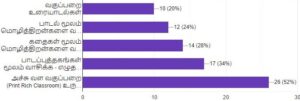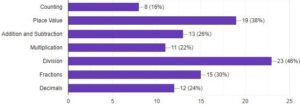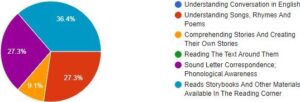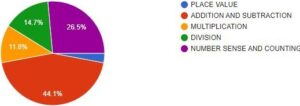Specific Learning Skills Survey to Help Teachers Address Learning Loss: Lessons from Puducherry
By Anand S
Introduction
When schools reopened in Puducherry after a long time in January 2021, it was realized that the students were mentally not ready for regular school activities. So, we developed a bridge course and provided a Bridge Resource Kit to the teachers to help students get ready for regular school activities. At the end of the bridge course, a learning gap among the students was observed. We conducted a specific learning skills survey among the teachers, which helped them zero in on where students were facing problems. These learning problems were articulated in the form of specific learning skills in the survey. This article explains how we supported teachers by conducting this specific learning skills survey among the students.
Bridge Course – Support in the field
The Bridge Resource Kit was distributed to teachers to employ the activities suggested in addressing the learning gap caused by the pandemic. The kit contained lesson plans, pictures, games and activities, audio-video resources, concrete materials, like tamarind seeds and A3 size posters etc. A Google form was created and used to collate resource requests from the teachers and to get support for their classes.
The Google form link was shared in teachers’ groups so that it could reach all teachers. It was realized that a few teachers were not able to access it due to various reasons, like lack of awareness or not having smartphones. The resource persons assisted teachers with this, and the resource request Google form helped us track and support teachers in an effective manner. We requested the district institutes to share this in the teachers’ official WhatsApp group to reach all teachers. It was also observed that a few head teachers and teachers had also observed the learning loss and they were trying to address this in their own way. The district institutes were also checking all the schools to ensure teachers’ support in addressing the learning loss.
School visit record
We created a Google form to capture school visits to save time since it can capture the data automatically. The school visit record form covered details, such as the name of the school, name of the teachers, the kind of support they need, weekly plan, visit notes and observation, photos of the visit, feedback etc., The collated data can be directly stored and shared in an Excel sheet. The school visit data helped us plan for school visits in the coming weeks.
Specific learning skills survey
Assessment tools were prepared in the month of February 2021 for Tamil, English and Maths in order to find out the percentage of learning loss among the students. It was decided to conduct a pre-test at the end of the utilization of bridge course modules, i.e., after two weeks. But due to some logistical issues, we could not conduct the pre-test.
After two weeks of identifying the needs of teachers and the challenges of students, another Google form was created and named ‘Teacher’s Needs & Students’ Challenges’. As suggested in the handbooks (Azim Premji Foundation) the common needs and challenges were listed out in the Google form using the cohort titles given. Fifty teachers responded to this common form, and it helped us understand the areas in which teachers and students need additional support.



To identify the specific needs of teachers and the specific challenges of the students, we adopted the ‘Action Research Approach’ suggested in the NCERT modules (from their online course on Action research). We discussed and decided that we could conduct a survey among teachers to zero into specific challenges faced by students in each cohort. Initially, the team tried to list out the challenges using the desired practices listed in the handbook. But we could not frame enough items and the practices were generic when we connected them with students’ specific challenges. We referred to the Tamil Nadu SCERT syllabus document to list out the Tamil-specific learning challenges of students in each cohort. The syllabus document has listed out ‘specific challenges’ under each skill and mapped it with each class.
We developed ten survey tools using learning practices given in the handbook and the Tamil Nadu SCERT syllabus. Each teacher was asked to select the survey tool/cohort area according to their current needs and challenges. To make the tools more comprehensible, the survey items were provided in both, English and Tamil (L1-mother tongue or first language). The purpose of each tool was explained to the teacher. Likewise, English and Mathematics tools were also developed using Tamil Nadu SCERT syllabus document and the Foundation’s maths handbook. The teachers were interested in the survey, and they asked questions about the items/specific skills. We created a Google form for the survey data that captured/tracked students’ specific challenges under each cohort title. Cohort specific challenges are named and listed in a different section.



Likewise, cohorts were developed for English and Maths based on the survey results. After collecting the data, the team decided to develop new resources and collate old resources on shared folders under each cohort title. The cohort-based resources will save time and help the team to select suitable resources based on the specific needs of teachers.
The collected data was analysed and categorized based on, one, the number of problems identified by each teacher in the respective Tamil/Math cohorts and two, Tamil/Math learning problems statement-wise, collective data. The data contains the collective response of all teachers in each statement in the form of percentages. The first type of categorization helped us to track each teacher’s classroom practices and the second type of categorization helped us to track the overall improvement of students in a set of schools. The data contains both teacher cohort-wise and Tamil learning problems-wise categorized tables. Based on the survey results, teachers were categorized into different cohorts.
The following table contains a list of student-specific learning problems based on the observation of teachers. For this action research, to find out the more problematic areas/issues of the students, teachers were asked to read the specific maths/Tamil learning skills listed. They were instructed to identify if more than 50 percent of the students had not acquired the listed skills. The detailed notes on the objectives and methodology of the study will be written soon. The following is a representative sample of the data and analysis to represent survey results.
Learning problems or specific learning skills-wise categorisation
| Addition and Subtraction | Total problems (60% means 6/10 teachers identified the problem as not solvable by more than 50% of the class) |
| Students can identify the signs of addition and subtraction | 7% |
| Students can solve the column-wise addition (solve 27+18 and write 45 instead of 315) | 21 % |
| Students can estimate the sum of the two numbers (estimates the sum of 19 and 28 is lesser than 50 instead of more than 100) | 64 % |
| Students understand that a number can be written as the sum of two other numbers (18 can be written as 0+18, 1+17, 2+16…) | 57 % |
| Students can solve horizontal addition problems (13+19 =?) | 71 % |
| Students understand the word problems and are able to solve through appropriate operations | 85 % |
| Students can create their own word problem for a given statement, such as 3+4=7 | 85 % |
| Students can subtract zero without making a mistake | 57 % |
| Students can explain the logic behind the standard algorithm instead of memorizing it | 71 % |
We observed that when the difficulty level increases, students’ learning problems also increased in a specific learning skill. This will help us to focus on the students’ problem areas. This data will also help us plan and conduct workshops and seminars on specific learning problems. The results of the survey were shared with teachers to make them realize what they need to focus on to improve teaching and learning. The results were also useful in selecting suitable worksheets based on each student’s learning level.
Key takeaways from the survey
- The team decided to add ideas, resources for each identified maths learning problem in each cohort. The ideas and resources were shared with teachers to address the maths learning problems that were identified by the teachers in the survey.
- There is a need to map the teaching practices, specific learning skills and teaching and learning resources (TLMs).
- The survey data was based on the observation of the teachers. A paper-pencil baseline test would have served the purpose better.
- We were supporting the teachers to address the specific learning issues using graded worksheets available on some websites. It would have been great if we had developed or collated specific learning skill-wise worksheets.
- Worksheets will not help to address all the specific learning problems. We need to provide concrete learning materials to address these.
- Continuous observation is necessary to monitor whether all students have acquired all the learning skills.
- More than 90 percent of the teachers in the selected schools participated in the survey.
- The teachers realized that there was a learning loss among the students.
- The survey created a platform to discuss the specific learning problems of students freely. Teachers took active participation and our work with them became more focussed.
- It would have been better if we have already developed a handful of resources to address specific learning skills listed in the survey.
- The survey helped us have a more focussed conversation with the teachers as they could ask us questions related to items listed in the survey.
- The survey also highlighted the need for specific skill or competency-based approach in the field.
AUTHOR
Anand S, Resource Person, Azim Premji Foundation, District Institute, Puducherry

